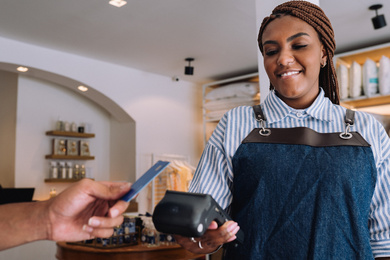Three ways banks can attract more women customers

And their optimism is not unfounded. Banks from Costa Rica to Paraguay are launching financial products and services tailored to the specific needs of women entrepreneurs, as they plan to increase the quality of their portfolio while having social impact.
What they offer ranges from women-targeted loans for working capital and investments to credit cards, housing loans, programmed savings, checking accounts and insurance products. This offering is further complemented by non-financial services including networking events for women entrepreneurs and training programs. Given women’s comparatively better savings behavior, demonstrated loyalty to banks and lower credit risk, many banks aspire to be the financial institution of choice for women in the region.
As banks are increasingly tapping into this market opportunity, some are poised to take the lead with the support of the women entrepreneurshipBanking (weB), an initiative managed by the Multilateral Investment Fund (MIF) and IDB Invest (formerly known as Inter-American Investment Corporation). weB leverages financial institutions’ local client portfolios to bring financing, financial knowledge, capacity building and access to networks to women clients across the region.
With banks from across ten countries, the initiative has approved more than $600 million in lending and nearly $5 million in advisory services since 2012. Among the members are local and international powerhouses like BAC San José, Banco Pichincha and Itaú Unibanco.
Through the weB initiative, banks are able to access resources for lending as well as advisory services for insights into the women’s market. Benefits also include support for the design of non-financial services for female clients and access to key membership associations, such as the Global Banking Alliance for Women (GBA).
A recent review of the weB initiative commissioned by the Multilateral Investment Fund found that client banks, on average, have increased the number of women-led companies in their portfolio. Their success comes down to three main factors:
1) They implement a multifaceted strategy
Successful weB banks, such as G&T Continental in El Salvador, create strategies that have sufficient depth and realistic, yet ambitious targets with adequate corresponding budgets. They promote buy-in from all members of the financial institution, including senior management, and they actively train their staff and management to achieve their women’s market goals.
To get to know their women clients, successful weB banks research the market extensively to deeply understand their needs. They offer their clients the financial tools they need as well as high-quality training and networking opportunities.
2) They embed the program in different parts of the organization
High-achieving weB banks appoint technical specialists throughout the institution to serve the women’s market, including human resources, strategy, legal, operations and finance, ensuring that the program is fully and consistently embedded.
weB banks like Banco Nacional de Costa Rica are aware of the value of sex-disaggregated data and create systems in their databases to identify women-led businesses, as well as monitor and evaluate women’s sales and employment growth. These data are also used to assess progress on institutional targets.
3) They strategically market their program
weB banks position themselves in their respective markets with strong, clear branding and outreach efforts to attract women customers. They advertise their financial products and training opportunities to the women’s market with clear messaging and flexibly craft their non-financial offering to meet women’s time demands.
Itaú Unibanco, for example, is a leader in effectively marketing and promoting its Mulher Emprendedora program. The Brazilian bank leverages online marketing with targeted visuals attracting women entrepreneurs and holds dynamic in-person forums and networking events.
IDB Invest is now expanding weB programming in the region and has partnered with the Multilateral Investment Fund and GBA to build the capabilities and knowledge of weB members and interested financial institutions in Latin America and the Caribbean. From May 22 to 26, 2017, IIC´s partner in the Dominican Republic, Banco BHD León, will host the GBA All Stars Academy, a training opportunity on how to design and operate successful women’s market programs.
To find out more about the weB initiative, financial institutions are encouraged to contact the IIC at [email protected].
LIKE WHAT YOU JUST READ?
Subscribe to our mailing list to stay informed on the latest IDB Invest news, blog posts, upcoming events, and to learn more about specific areas of interest.
Subscribe



